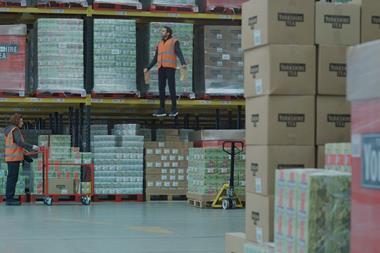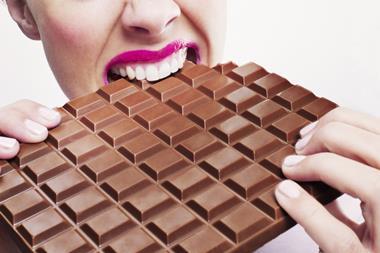From warming up on a winter’s day, to getting going in the morning, there’s a brew to fit the bill. C-Store looks at the trends in hot beverages
Anyone who dares mock the UK’s love of hot beverages obviously hasn’t endured a winter on our shores. Because, when the wind howls and the cold bites, there’s nothing like a nice cup of something warm to revive flagging spirits.
Perhaps it’s because hot beverages are so close to our hearts that it’s a category occasionally taken for granted by c-store retailers. Which is a shame, since 165 million cuppas are slurped every single day here in the UK, while an impressive 85.9% of consumers choose to buy their everyday black tea from the local convenience store (Nielsen).
In Southampton, Richard Inglis keeps a close eye on every category across his three stores using a sophisticated epos system installed last year. “But I have to confess that when I was asked how my hot drinks were doing, my first thought was ‘I don’t have a bloody clue!’,” he laughs.
Luckily, his system made it easy to crunch the numbers for sales across the past few weeks. And after he’d done so, the results were surprising, even to his seasoned retail eye.
“Right at the top were the PG Tips Pyramid Tea Bags,” he says.
“Fine, I expected that, it’s a great everyday seller. But what I didn’t expect is that numbers two, three, four and five on my top sellers’ list were all hot chocolate. It really was the ultimate winner in the hot drinks category at all our stores.
“To put it into context, my first coffee doesn’t appear until right down the list at number six.”
Richard thinks that this sales surge might be down to customers seeking out something indulgent to see them through when the temperature drops.
He reckons that the brands that win out tend to be hot chocolate mash-ups backed by the bigger names in confectionery, through products such as Cadbury Wispa Drinking Chocolate and Maltesers Malty Hot Chocolate (although, on a lighter low-cal note, Options White Chocolate also made the list).
It’s a cheering seasonal trend that has also taken hold up in Preston, where Steph Latham from Lostock Hall Spar finds that hot chocolate sales have been “amazing” since winter hit, making it the current star in hot drinks.
“One of our suppliers advised us to try merchandising the Haribo Mini Marshmallows alongside our hot chocolate and it’s really done the trick with sales,” she says.
Premium and health boost tea
According to Nielsen, tea remains the nation’s go-to hot beverage with a 58.7% share of total consumption, compared with coffee at 37%.
As the trend towards premium tea gathers momentum, the coffee chains are catching on, with Starbucks launching its own loose-leaf Teavana range last year. And that’s great news for the big tea brands such as Tetley.
“The number of people buying tea has increased, as has the frequency of purchase,” says Peter Dries, director of customer and shopper marketing for Tetley.
“Tea is increasing in popularity and its recognition as a healthy beverage has created opportunities to increase revenues, particularly of healthier teas such as fruit and herbal, decaf and green.”
One of the on-going challenges to growth is rocketing commodity prices, but Dries says that tea still wins out on value at the till. “It’s worth noting that, cup for cup, the average price of a cup of tea is about 3p, compared with coffee averaging 9p a cup, so still offers great value for money.”
Treat factor
So why does she think hot chocolate is suddenly so popular? Steph believes that it’s down to the high street coffee chains upping the treat factor of hot chocolate and turning it into a popular choice for people wanting an indulgent break from their everyday out-of-home latte.
“If you go into Starbucks or Costa you can see lots of people having them with the extra sweet bits and the whipped cream, and they look really good,” she says.
“What we’re doing with the marshmallows is giving customers the opportunity to recreate the same thing at home. My boy absolutely loves them, but I reckon it’s not just kids, it’s popular with anyone who wants a treat to have at home on a winter’s night.”
Richard maintains that the trend will probably make him rethink his lines in hot drinks, and reinforces the importance of leveraging in-store data to make more sales.
“It’s funny,” he says. “You end up doing more things like coffee because you think it’s the in thing, but after looking at the figures I’m not convinced it’s selling amazingly well for us. I think that it may be because people round here don’t tend to make coffee at home that much; they’ll have it out.
“However, we also have a coffee machine, so where we’re losing out on the shelves we’re probably making up for it with hot drinks to go.”
Still, Richard says that whatever the individual sales, it’s vital to have good availability for the main hot drinks sub-sectors (coffee, tea and hot chocolate) on the aisles as they all drive footfall and boost basket spend across the board.
“Hot drinks is a category that customers come in for every single day,” he says. “And if you don’t do it properly then you’re going to miss out on the associated milk and bread buys that tend to go with it in our stores.”
One thing very apparent in the hot drinks category is that trends can vary from c-store to c-store, depending on local tastes. For instance, Richard says that he’s never done particularly well with coffee pods, which he thinks that his savvy customers choose to order in bulk from online retailers such as Amazon.
Yet for Sam Coldbeck at Wharfedale Convenience Store in Hull, they’ve been a powerful customer draw for a while.
“What we have noticed is that the coffee capsules are becoming really popular,” she says.
“We weren’t doing the Tassimo and Dolce Gusto capsules this time last year, but now they’re doing very well for us. The other thing that tends to do well in hot drinks at our store is the Nescafe 3 in 1 Instant Coffee Sachets.
“For the workmen who come in, they’re really good. They’ve often just got a kettle on site and it’s an easy way for them to make a coffee without having to mess about with milk and sugar. It’s all down to convenience in the end.”
She adds: “Again, it’s something that we didn’t do a year or 18 months ago.”
Sam’s strategy sums up how many c-store retailers are approaching the sector: stick with the core sellers, while keeping an eye out for potential shelf superstars coming through. In Sam’s store hot drinks are kept to a two-metre bay area, well-stocked with PG Tips and Tetley, which for her customers are the “main brands”.
“We’re obviously a Yorkshire Tea area up here, so we do absolutely everything from them, which people really like,” she says.
“I do find that in hot drinks customers tend to stick to what they know and like. Some people might be swayed by a new brand if they can save a couple of pennies, though it’s very much a favourite-led buy. People definitely keep going back to their favourites.”
Sweet sensations
C-store retailers report that sales of hot chocolate seem to be setting the pace for the sector, leading a £28m market (IRI).
“It’s definitely a product for people who want a bit of a treat,” says Steph Latham from Lostock Hall Spar in Lancashire.
“In winter, rather than go for a coffee or tea they want something sweet that’s going to make them feel nice and cosy.”
Instant hot chocolate now makes up 52% of the overall hot chocolate sector, giving customers the opportunity to make coffee shop-style drinks at home. And when they’re in-store they’re likely to go for names they already enjoy in confectionery, such as Galaxy and Maltesers.
This winter, Mars Chocolate Drinks and Treats launched two new products into the hot chocolate category: Galaxy Mocha Latte and Galaxy Thick Hot Chocolate. The Mocha Latte intensifies the coffee-chain ties, while Thick Hot Chocolate ups the indulgence factor with a richer experience.
“Traditionalists will love Galaxy Thick Hot Chocolate, while more adventurous consumers will get to try something new with Galaxy Mocha Latte,” says Michelle Frost, general manager for Mars Chocolate Drinks and Treats.
“Galaxy Mocha Latte sees the first coffee variant to be added to our hot chocolate range, offering consumers something innovative. With the combination of strong brands and eye-catching packaging, we hope to drive category growth even further.”
Relatively high price points can also be a barrier to trial. Post-Brexit, higher commodity prices are being passed on to customers, often leading to price rises across the offer.
This means that in some c-stores, customers are only dipping into pricier brands when they’re on promotion.
“In our store we sell the micro-ground coffees (such as Nescafé Azera), but they tend to do so much better when they’re on promotion,” says Steph. “I think that people see it as a nicer cup of coffee all round. They also don’t want to pay going on £5 for an everyday buy, so they get it when it’s cheap, or just buy it in for special occasions such as when they’ve got relatives coming round.”
Overall, the staples at Steph’s store are the big mainstream brands, sold at the right price. “We’re very close to industrial units, so you often find workmen coming in for the bigger jars of coffee and your big boxes of tea bags for what we call the ‘brew room’,” she says.
“Usually, you find that people go for the branded stuff mainly, over own brand. Speaking personally, I love PG Tips, and I’m not keen on anything else. It’s the same with our customers.”
Milking the dairy-free trend
With the number of Brits who shop the free-from fixture more than doubling in the past two years (Harris Interactive) more shoppers are looking for moo-free milk to put in their tea and coffee.
“There are many reasons why more people are choosing dairy alternatives,” says Camilla Barnard from Rude Health.
“For some who are lactose intolerant, it is a dietary requirement. For others, it is a lifestyle or ethical choice, but there is also a large and growing proportion of consumers who enjoy being able to alternate between having dairy or using a dairy alternative”
Rude Health launched its first dairy alternative, The Almond Drink, in 2013. Since then it’s released a total of seven dairy-free drinks, the latest of which is its Tiger Nut Drink.
“Competition within the market has caused companies to invest in innovation within the category and seek out better quality ingredients and more interesting flavours,” says Barnard.
“Choice and accessibility invoke curiosity and mean that more consumers are finding a dairy alternative that they enjoy.”
Changing tastes
Naturally, c-store retailers want to sell whatever’s most popular with customers – and at the moment big brand tea is a huge part of the market. However, if you look at the bigger picture, it appears that shoppers’ tastes are rapidly changing. In fact, overall sales of traditional black tea are down 7.8% in convenience (Nielsen) as customers seek out something new to try.
“Sectors outside black tea have grown significantly and shoppers now have a much wider choice of tea available to them, with many choosing different types of tea in addition to their normal buy to drink at different times of the day,” explains Peter Dries, director of customer and shopper marketing for Tetley.
“In time it is anticipated that the growth areas of tea will exceed everyday black tea sales.”
You can see the start of this change in the official sales figures. Value sales of green teas are up 5.2% in Scotland, with Redbush up 3.3% and decaf up 7.4% in England.
Yet despite this potential storm in a tea cup, not all retailers have seen massive growth in green tea and the like – so far.
“To be honest, herbal teas don’t seem to go that quickly for us,” says Steph. “In our store we do peppermint and green tea. I think in our local area people are not over-keen on those kind of drinks, although I believe other shops do well with unusual teas.”
As well as new varieties of tea, brands are also trying to give coffee a kick in convenience through fresh innovations.
One future-facing format is the coffee bag, currently pioneered by Lyons. As the name suggests, the coffee bags are made with ground coffee, sealed into individually wrapped foil bags.
“Consumers are increasingly recreating their favourite hot drinks at home and turning away from poor-quality instant coffee,” explains Nicole Hartnell, brand manager at Lyons Coffee.
“The demand for a high quality coffee is ever rising as consumers are developing a taste for fresh coffee and becoming open to trying new things. The growth of coffee culture throughout all regions of the UK would suggest that retailers should look at expanding their coffee range to mirror the current consumer habits and trends.”
With plenty of new trends bubbling under in hot drinks – from cold brew coffee to lychee-infused green teas – there’s lots for c-store retailers to consider stocking in 2018 and beyond.
However, Sam says that to keep the category front and centre in-store, suppliers need to consider the margins available for retailers. “The one thing I really need to say to every supplier is that we’re being pushed more and more on profit these days,” she asserts.
“Everyone’s reducing their profit margins, and us retailers are at the end of the chain. With costs such as wages rising, this is a real problem. So, I’d say, please remember that for everyday products such as tea and coffee, we’ve got to make a fair profit, too!”























No comments yet